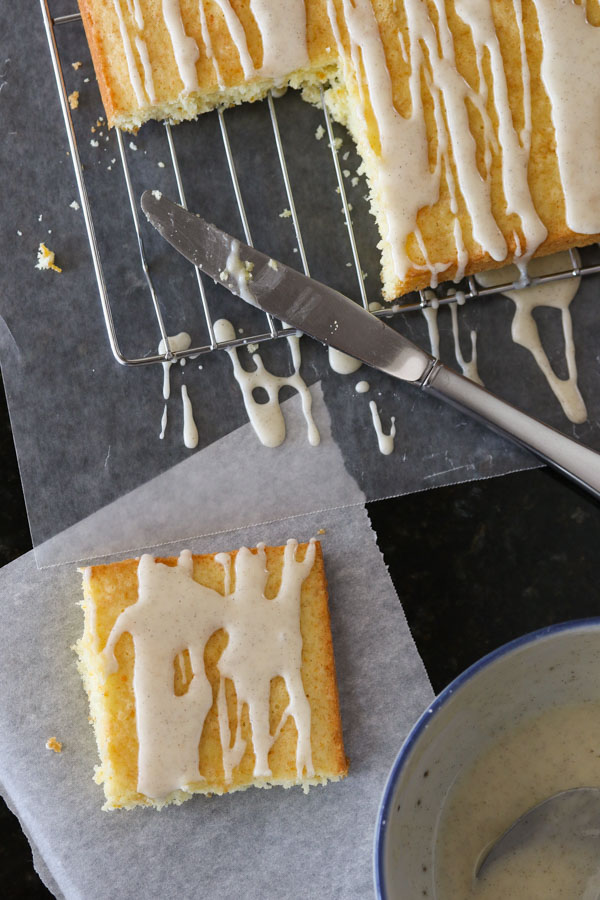
this is the story of a cake that almost wasn’t. well, no, that’s not true. in my head, this olive oil orange cake with cardamom glaze was going to be so good, i knew i had to figure out how to make it happen. but it took some doing. olive oil citrus cake recipes are plentiful this time of year, but the first few i tried weren’t quite right.
recipes with terrifyingly large quantities of sugar were dismissed offhand. the first recipe that i was actually willing to try had a pretty significant quantity of olive oil and just a small bit of yogurt. also? it made a fantastic mess all over the kitchen counter and my clothes as blood orange juice sprayed everywhere when i was breaking up the oranges as directed by the instructions. that cake turned out ok, but the orange flavor was milder and the the cake denser and spongier than the as-yet-uncreated one that i was determined to make. (and it wasn’t until later, of course, that i read that blood oranges actually have a milder flavor than other orange varieties. at least i was able to scrub all of the pink splatter stains out…)
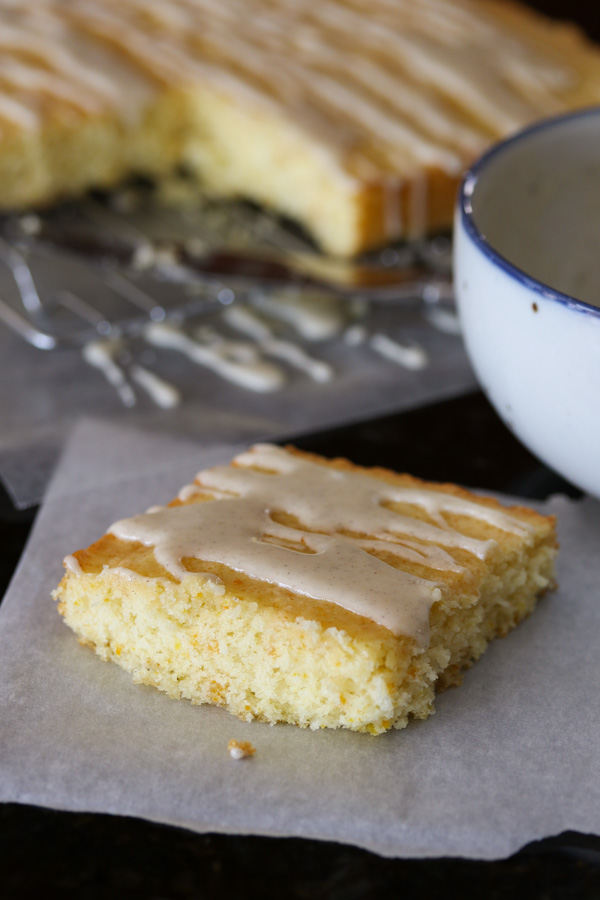
round two was based on a recipe that basically flipped the volumes of yogurt and olive oil, which was, in theory, more aligned with what i wanted, at least from a nutrition perspective. and yet, despite the number of times that i have been unpleasantly surprised by the gummy outcome when i get overzealous with the quantity of yogurt in a recipe, i was STILL caught off-guard when this cake turned out to be gummy and squidgy.
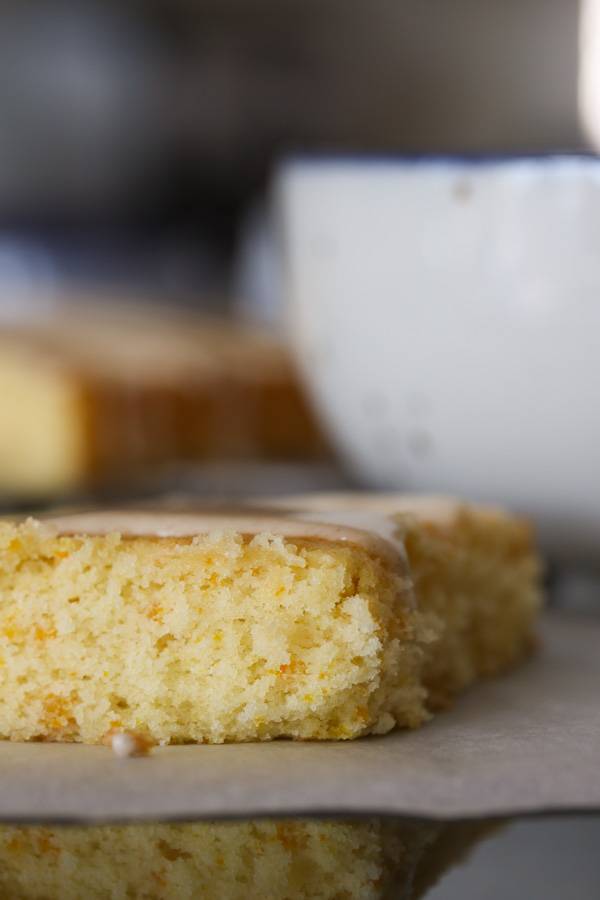
at this point it was clear that i needed to head back to the drawing board, by which i mean internet. the cake in my head was light but not too light, and fluffy but not dry, and very moist but not spongy. after scouring all of my usual haunts on the interwebs, i concluded that no one else wanted olive oil cake that fit these parameters. everyone else was happily churning out pound cakes made with olive oil. which is great, except that it was not how the cake in my head was meant to be.
realizing that the internet was not going to solve this dilemma for me, i headed off to my local library (can we just take a moment to gush about how wonderful libraries are?! they are full of all sorts of interesting things that they let you take home with you for free! what could be better??). sitting on the floor of the cookbook section, i dutifully checked the indexes of probably 50 cookbooks, looking for olive oil cake recipes that seemed like they might possibly be manifestations of the cake in my head. my most promising lead came from thomas keller and sebastien rouxel’s bouchon bakery cookbook. in the headnotes, they describe the cake as having a “light, delicious crumb”, which sounded like exactly what i was trying to achieve.
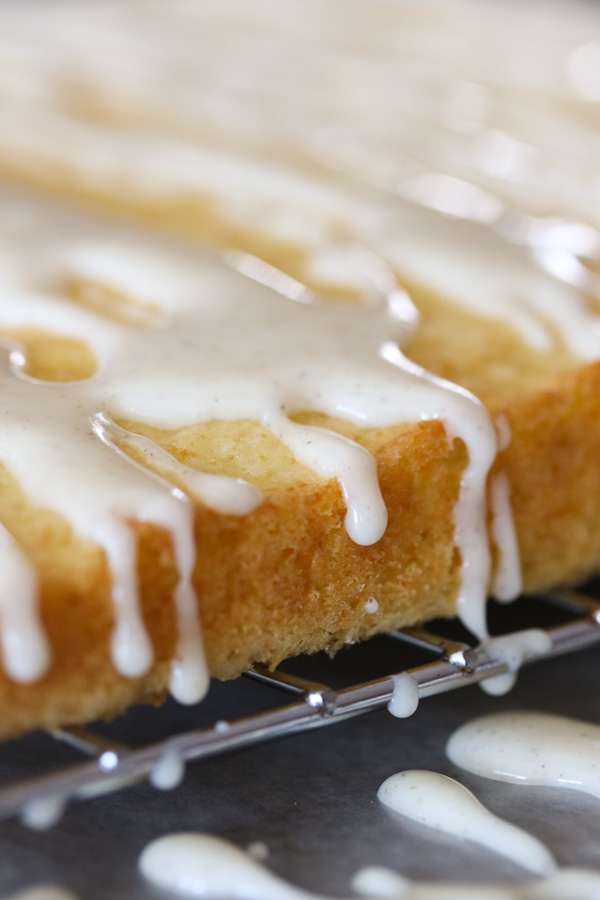
now, a side note that will later become relevant: recently i read an interview with deb perelman of smitten kitchen in which she remarks on her skepticism towards recipes written by chefs who spend all of their time in professional restaurant kitchens, citing the unwieldy recipes that tend to result. as someone who, for whatever reason, doesn’t follow closely many fancy restaurant chefs, i haven’t had much exposure to this phenomenon. two things i learned from this bouchon recipe: 1) deb is right, and 2) it’s worth it anyway, in this case.
with my third round recipe in hand, i headed to the kitchen. determined to create the cake i knew was possible, i dutifully followed the recipe, straining and weighing my eggs (oh yes). since the recipe that i had found was for a plain olive oil cake and i wanted one with a strong orange flavor, i opted to use orange zest and orange oil to create that flavor with minimal effects on the texture. it wasn’t until i had spread a relatively small amount of batter into a 9” x 13” pan that i began to question the recipe. i assured myself that the cake would rise in the oven and not remain this silly thin layer that it was presently. um, not so much.

round four! round four basically took the round three cake, added a tiny bit more orange oil, and put it in a smaller pan so that it would be a more reasonable height. i steered away from going all the way to a loaf pan as i wanted to maintain a good amount of surface area for the cardamom glaze and found a square pan to be a good compromise. success, finally! i dare say the real olive oil orange cake with cardamom glaze is even better than the one in my head (though perhaps that’s because real cake is always better than imaginary cake).
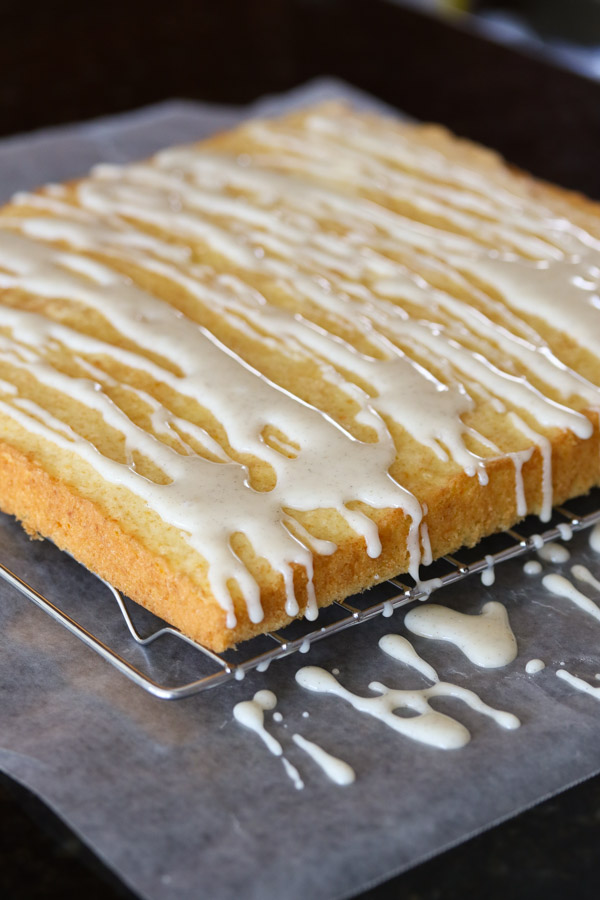
olive oil orange cake with cardamom glaze
Ingredients
cake
- 2 oranges
- 145 g. (5 1/8 oz. / 1 cup + 1 teaspoon) all purpose flour
- 3 g. (½ + 1/8 teaspoon) baking powder
- 158 g. (5 ½ oz. / ¾ cup + 2 teaspoons) granulated sugar
- 2 large eggs
- 113 g. (just shy of 125 ml / close to ½ cup/4 oz.) milk (the recipe calls for whole but i used 2%)
- 79 g. (3 oz. / ¼ cup + 2 tablespoons) extra virgin olive oil (nothing too peppery or bitter)
- ¾ teaspoon boyajian pure orange oil, optional
glaze
- 1 cup powdered sugar, sifted (i usually ignore instructions to sift but really recommend it here otherwise you could end up with lumpy glaze)
- ¼ – ½ teaspoon ground cardamom, to taste (start with the lower amount as it’s easy to add more and cardamom strength can vary considerably)
- ~2 tablespoons orange juice
Instructions
cake
- preheat the oven to 350° F. butter the bottom and sides of a square baking dish (the one i used was 9” x 9” but yours will likely be 8” x 8”). cut a square of parchment to fit the bottom of the pan, put the parchment in the bottom of the pan, and butter the parchment. (for dairy free, you can substitute another solid at room temperature shortening but stay away from nonstick spray as i found the cake still stuck with spray).
- combine the flour and baking powder in a medium bowl and whisk to combine.
- thoroughly wash and dry the oranges. using a microplane grater (easier) or the smallest holes on a box grater, zest both oranges completely. add the zest to the flour mixture and use your fingertips to distribute the zest evenly throughout the flour and break up any clumps. set aside.
- combine the milk, olive oil, and orange oil; set aside.
- crack the two eggs into a small bowl. whisk to combine the whites and yolks. put a fine mesh sieve over another small bowl and pour the eggs into the sieve. according to bouchon bakery, this step removes the chalazae, which are the white spiral bands which attach the yolk to the membrane (look how much we’re learning together!). from the second bowl of strained eggs (please know i have a hard time typing this with a straight face), measure out 50 g. (3 tablespoons) and place it into the bowl of a stand mixer.
- add the sugar to the eggs and use the whisk attachment to beat the mixture for 1 minute on medium-low speed (4 on a kitchenaid). once the eggs and sugar are combined, increase the speed to medium (6 on a kitchenaid) and whip until the mixture is pale yellow and thick (it will still be gritty), about 5 minutes. turn off the mixer and use a rubber spatula to scrape down the sides and bottom of the bowl. turn the mixer back on and set to medium-high (8 on a kitchenaid) for another 5 minutes or so, until the mixture has thickened.
- turn the mixer back down to medium-low (4) and pour in half of the flour mixture then half of the milk mixture. once that is well combined, add the remaining flour mixture then milk mixture, again mixing until it’s well combined. turn off the mixer and scrape down the sides and bottom of the bowl to be sure everything is combined.
- pour the batter into the prepared baking dish and use a spatula to ensure an even layer across the dish.
- bake for 22 – 25 minutes, until a toothpick comes out of the center clean and the top of the cake springs back to shape within a few moments of gently pressing on the top of the cake. set on a rack to cool in the pan for 10 minutes. after 10 minutes, run a thin rubber spatula around the edges to loosen the cake then invert a rack over the pan. flip the pan and rack over together to release the cake. peel the parchment paper off the cake and discard. place a second rack on the “top” of the cake (formerly the bottom) and flip it once more to cool completely with the bottom on the rack.
glaze
- when the cake is nearly cool, combine the glaze ingredients in a small bowl. start with 1 tablespoon of orange juice, which won’t be enough, and then add more in increments that seem too small to make a difference (about ½ teaspoon). the icing quickly goes from too dry to just right to too runny to stay on the cake. taste and add more cardamom, if desired.
- slide a piece of wax paper under the cake rack then drizzle the glaze over the top of the cake. cut into squares and enjoy immensely.
Notes
oranges: i don’t always buy organic produce but since one of the recipes i consulted pointed out that zesting is basically grinding pesticide into your cake, i figured i would at least see how much the organic oranges cost…and they were cheaper at my store!
orange oil: luckily for me, my local produce store in MA carries boyajian pure orange oil. the boyajian website sells it, as well as providing a store locator link, and it’s available from other online retailers. other orange oils and extracts would likely work here too, but i can’t give you an exact measurement for how much to use, only a caution that oils and extracts are potent and it’s easier to add more than to take it away if it overpowers your cake. the ¾ teaspoon of boyajian orange oil provides an assertive orange flavor.
measurements: keller and rouxel provide measurements in grams, with the cups/spoons measurements noted to the side. as you would expect from professionals, they are very precise and also not necessarily round numbers since the at-home version was scaled down from commercial bakery volume. for best results, use the gram measurements, if you have a scale that works in grams.
cake adapted from thomas keller and sebastien rouxel's bouchon bakery cookbook.
Nutrition Facts
olive oil orange cake with cardamom glaze
Serves: 9
| Amount Per Serving: | ||
|---|---|---|
| Calories | 263 | |
| % Daily Value* | ||
| Total Fat | 0 | |
| Saturated Fat | 0 | |
| Trans Fat | ||
| Cholesterol | 0 | |
| Sodium | 0 | |
| Total Carbohydrate | 0 | |
| Dietary Fiber | 0 | |
| Sugars | ||
| Protein | ||
| Vitamin A | Vitamin C | |
| Calcium | Iron | |
* Percent Daily Values are based on a 2,000 calorie diet. Your daily values may be higher or lower depending on your calorie needs.
tasty seasons
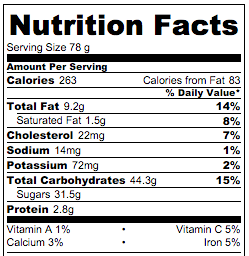

 Save to BigOven
Save to BigOven
I love your observation that real cake is always better than imaginary cake–it totally is, and OH MY GOODNESS this one is delicious! Orange-y and cardamom-y, fluffy and moist and delicious, especially with a cup of herbal tea. Yum!
yay! i’m glad that you liked it lauren!
Hi,
I happen to find this page and love l orange/olive oil cakes.
I got confused in paragraph no. 5 : after wisking and straining 2 whole eggs, do I just use 3 T. in the cake?
Please clarify. My best,
Mira
hi mira,
i’m glad you found this recipe and i hope you enjoy it! yes, you just use 3 T of the eggs for the cake. the rest you can save for tomorrow morning’s scrambled eggs. 🙂
enjoy!
kate